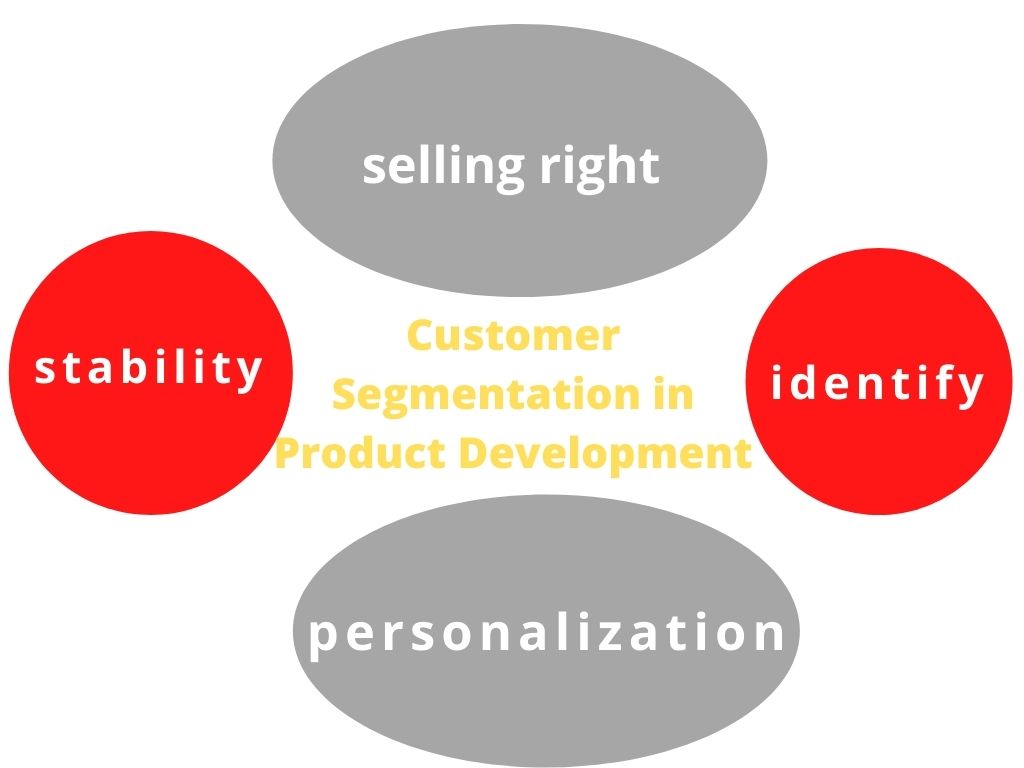How customer segmentation can be used in product development?
Customer segmentation is a well-known marketing strategy to attract leads, but one of its uses is also for new product development.
Customer segmentation can be a tool for market entry strategy to identify potential customers, if any, for a new product or service.
As a business, you can deploy customer segmentation models to uncover new customer requirements to then come up with new products to fulfil those needs. This is a more scientific way of launching new products or services.
Such result-based segmentation thus helps business managers overcome product development challenges. (We’ve explained this in detail further down the post.)
A parallel example here could be that of content explosion. With so much content being churned out daily, marketers are no longer sure of what is really resonating with the audience. That’s where customer personalization comes in, allowing the creation of tailored content to suit individual clients.
The same logic applies to using customer segmentation for product development or innovation.
Want to know more about Express Analytics’ customer segmentation model, Speak to Our Experts to get a lowdown on how the customer segmentation model can help your product development.
With technology evolving at a fast pace today, companies should have a customer-focused, product development approach rather than launching a product and then finding the right customers for it.
Such a method is also recommended for product expansion or scaling where the thrust is no longer on a broad spectrum of potential customers, but on a subset. The key to doing so is through customer segmentation.
This approach also gives companies an edge over the competition when entering the market.
Benefits of Using Customer Segmentation in New Product Development
This method offers several advantages. One of them is getting more bang for the buck from your Sales dollar.
Efforts by the Marketing and Sales divisions in what later turns out to be the wrong segment can prove to be an expensive “experiment”.
It may also lead to loss of inventory control as unsold products pile up. Using customer segmentation in advance means not only selling right but also promoting the stability of your customer base.
Not only that but having a clear idea from the start of who your target audience is also led to greater customer satisfaction, better after-sales, and better performance against competitors.
How to go about Customer Segmentation and Challenges in the Way
To use customer segmentation for future products, you need to create a plan with a clearly stated objective(s), a list of the stakeholders involved, and the deliverables.
The identification of a new product idea or even the improvement of an existing one as a viable venture means to start using customer segmentation modeling methods to define your target audience.
If you choose to adopt this route, it is mandatory to develop and then test customer segment hypotheses and variables to delete the guesswork from the process.
A hypothesis is an assumption made on a limited knowledge basis that has to be validated to check whether it is true or false.
The hypothesis is, of course, put forth before any discernible research has been done. The product hypothesis largely works on the ‘If this then that’ logic.
Here’s an example:
Clothing company X believes that if it cuts black sleeve T-shirts, then they will be bought by athletic body type boys more than others. Or, if it also adds black to its product range of colored T-shirts, then gym-going teenage boys will buy it.
Once you decide to use customer segmentation to launch a new product, you need to start the process with research. Your business needs to gather the data needed for segmenting customer groups using primary and secondary research sources.
If you are using customer segmentation for improving existing products, data from existing customer data can be used.
The next step would be to create customer personas complete with characteristics such as behavior, lifestyle details, and so on to understand customer needs.
Use behavioral modeling to acquire new customers
But this approach of segmenting customers before launching a product presents a dichotomy for businesses.
How do you segregate customers for a non-existent product or service? That’s why you find many businesses using traditional customer segmentation methods to overcome this hurdle.
But the traditional classification schemes that classify customers using factors like demography, geography, etc., are meant for post-product launch. It’s like trying to fit a square peg in a circular slot.
Traditional segmentation models don’t work when applied to new product development.
Need-Based Customer Segmentation
To overcome this problem, as we had explained in our opening paragraphs, one way around this problem is to use need-based segmentation, the other is value-based.
Customer needs or wants represent the unfulfilled desires that could define a market for a new product or service. Or, even a new market itself.
Often, existing customers or even leads leave feedback behind that represents an opportunity to find out if a large enough market for the same exists, and if yes, to follow up and launch a product/service that caters to that need.
At other times, such needs surfaced during primary market research.
Here are two examples of Customer Segmentation: Taking off from the black vests example, some customers have left behind feedback with the clothing company that black cut sleeve T-shirts with round collars are what they were looking out for.
Or, market research throws up a common suggestion that the gym attire segment requires a cut sleeve T-shirt but with a hoodie.
So, these two examples of customer segmentation show that segments are demarcated based on those different needs rather than typical characteristics such as industry size, for example.
Value-Based Customer Segmentation
Under this method, customers are put into groups according to their economic score (value).
From a business perspective, every customer who has done business with them represents a certain value. In theory, customer lifetime value equals the net value of the cumulative profits generated by a customer over his/her lifetime.
But before allotting the net value, your business also needs to include all costs that can be attributed to the addition of that customer, including the actual cost of acquisition, infrastructure costs, and so on.
Outside of this the business worth of a customer, values, the merit kind, is other important part of what is called Psychographic Segmentation.
This refers to what your customers believe in, what’s their opinion on a certain subject, what are their interests, etc. Psychological Segmentation focuses more on psychological factors like subconscious beliefs or motivations.
Once this entire exercise is done, your data analyst team will then have to identify the relevant variables and go on to confirm the hypotheses. There are several ways of doing so but that is the topic of another blog post.
In conclusion: Customer segmentation represents a double-edged tool: it is not only a way for marketing existing products or services, but businesses can also use it as a form of market entry strategy to identify potential customers, if any, for a new product or service.
Reference: Customer Segmentation: A Step-by-Step Guide for Growth
An Engine That Drives Customer Intelligence
Oyster is not just a customer data platform (CDP). It is the world’s first customer insights platform (CIP). Why? At its core is your customer. Oyster is a “data unifying software
Liked This Article?
Gain more insights, case studies, information on our product, customer data platform



No comments yet.